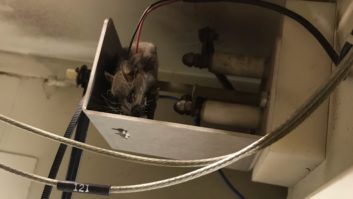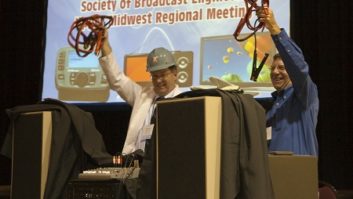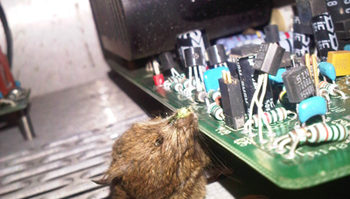What We Can Measure in Speaker Cable?Resistance (in ohms):
This effect turns electrical flow into heat. It affects all frequencies equally. Changing the size (gage) of the conductor changes its resistance. Resistance usually is specified per unit length (i.e., 100 feet, 100 meters, 1,000 feet etc.) and is additive.
Capacitance (in picofarads):
With speaker cables that are paired, or coaxial, the two conductors with insulation in between form a capacitor. Capacitors hold an electrical charge. The capacitance is small and measured in picofarads. It is additive and usually displayed per foot or per meter and must be multiplied by the actual cable length to get the total capacitance. Capacitance affects the signal level and is frequency-dependant. The higher the frequency, the greater the reactance caused by the capacitance and the greater the signal loss.
Inductance (in microhenries):
Inductance is the ability to hold a magnetic charge. All conductors have inductance. It is also frequency-dependent but is in series with the cable, as opposed to capacitance, which is in parallel. The inductance of a cable is small, and the effect is cancelled out by the capacitance. Therefore, inductance rarely is specified in manufactured cables.
Impedance (in ohms):
The total of resistance, capacitance and inductance. As frequencies get higher, resistance becomes less and less of a factor. At frequencies above 10 MHz or so, only capacitance and inductance are left, so the impedance settles to a “characteristic” value.
Skin Effect (in inches):
As frequencies get higher, the signal tends to travel on the outside or “skin” of a conductor. A minor effect for analog audio, skin effect isn’t a major factor until well into the Megahertz.
Copper Purity (in percent):
While some high-end aficionados require high purity, such as “six nines” (i.e. 99.9999 percent), most cable manufactured domestically uses ASTM B115 ETP copper, which is 99.95 percent pure.Well, I’ve been writing this column for almost four years. You’d think I would run out of things to say about wire and cable.
Oh, no. There’s lots to talk about. And one subject I have never talked about in depth is speaker cable.
Among the Internet newsgroupies I talk to, there is no other wire and cable subject that stirs up more mud than speaker cable. So, let me spend the next few columns trying to calm the waters and maybe filter out the truth from the snake oil.
Speaker cable conducts the output of an amplifier to a speaker. What we want is a cable that conducts the electricity to the speaker and has no effect on the signal. Well, of course, this is impossible. There will always be some kind of effect.
The real question is, what effects are they? And, which effects have an audible result?
Golden ears
After all, we’re talking about “hearing” the results. And this is the crux of the problem.
While I can tell you the resistance or capacitance of the cable (and a dozen other parameters), there is no current way to correlate these measurable effects into what you hear. Especially when the high-end crowd talk about ‘soundstage’ or ‘detail’ or a myriad of similar terms, there is no known laboratory process that will tell us the electrical parameters that cause these effects, or even if these effects exist at all.
In fact, while those high-end folks are arguing that point, let me tell you a story about a friend of mine. He is quite well known in the high-end audio community, but I have omitted names here to protect both the innocent and the guilty.
This friend was determined to see if a panel of highly-qualified judges could tell the difference between speaker cables. He took some 12 AWG zip cord and a number of other exotic speaker cables, you know, the ones which cost dozens or hundreds of dollars per foot.
He used a top-of-the-line amp, speakers and top-quality source material. All these choices were approved by his panel, as was the source material. He laid the cables out on the floor, in full view of the panel, and started by hooking up the 12 AWG zip cord. He had the panel listen for a few minutes to a number of selections, using 12 AWG zip as the “reference.”
Then he had his assistants go behind each speaker, and behind the power amp, to change the cable. And, of course, when they got to the expensive cables, well, the soundstage, the detail, it was dramatic! They played the same selections through each of the cables. While some of the panel members preferred one cable over another, they all agreed that they left the 12 AWG in the dust.
My friend told me the names and qualifications of the panel members, some of whom had advanced degrees. Others had spent their lives working in the professional audio industry. These were the tops of their craft. At the end of the test, they thanked my friend for such an enlightening experience.
My friend said he didn’t have the heart (or guts) to tell them what really happened. Each time the assistants went behind the speakers and amplifier to change cables, they had done nothing. The entire time the panel was listening to the 12 AWG zip cord.
Subtle vs. gross
What does this mean? It means that, like life, we hear what we want to hear.
If we think the hundred-dollar-a-foot wire is being used, then that’s what it should sound like. It’s not like the thousand-dollar tire on your Ferrari. If someone substitutes a 4-for-$100 cheapie tire, one sharp curve and you’ll know there’s something wrong.
Our ears are interpretive. They are not something we can measure. How very few of us have “perfect pitch” and can even tell the frequency we are hearing.
Does this mean that all wire sounds the same? No, it means that the measurable differences in wire do not always correlate with what we hear. That being said, I would also say that I could easily design two cables that would sound dramatically different. In fact, you could do such a test yourself.
For instance, if I had two speaker cables, and one was 20 pF per foot, and the other 1,000 pF per foot, I guarantee that you could hear the difference. If I compared 20 pF per foot to 30, I doubt any human could hear the difference.
Likewise, if you ran down 10 feet of cable to one speaker, and 1,000 feet to the other, I would bet you could hear that difference too. And it would be more than just resistance (signal level).
But these are gross differences. What we’re talking about are subtle differences, or maybe even differences that can’t be measured. If you change the jacket of a cable from PVC to Teflon, does it make a difference in how it sounds? Not according to anyone in the lab. But ask some high-end audio folks! For every two of them, you will get three opinions.
So what’s in a speaker cable, what electrical effects does it create and which of these effects make a difference? Next time, we’ll start examining the basic “laboratory” list of measurable parameters.











